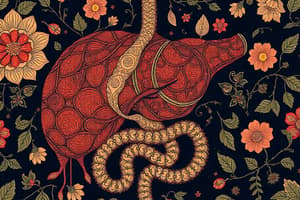Podcast
Questions and Answers
Where are monosaccharides converted into glucose?
Where are monosaccharides converted into glucose?
- Small intestine
- Liver (correct)
- Pancreas
- Stomach
What is the purpose of glycogen in the liver and muscles?
What is the purpose of glycogen in the liver and muscles?
- To store glucose for energy (correct)
- To store amino acids
- To break down proteins
- To produce urea
What is the role of the circulatory system in glucose transportation?
What is the role of the circulatory system in glucose transportation?
- To transport glucose from the liver to all parts of the body (correct)
- To transport glucose from the liver to the small intestine
- To transport amino acids from the small intestine to the liver
- To transport urea from the liver to the excretory system
What is the main function of bile salts in digestion?
What is the main function of bile salts in digestion?
What happens to excess glucose in the liver?
What happens to excess glucose in the liver?
Where are amino acids carried from the small intestine?
Where are amino acids carried from the small intestine?
Where is bile produced and stored?
Where is bile produced and stored?
What is the purpose of the liver in processing amino acids?
What is the purpose of the liver in processing amino acids?
What happens to bile pigments in the digestive process?
What happens to bile pigments in the digestive process?
What is the fate of urea in the body?
What is the fate of urea in the body?
What is the purpose of the bicarbonate in the pancreatic fluid?
What is the purpose of the bicarbonate in the pancreatic fluid?
What is the role of enzymatic digestion in the small intestine?
What is the role of enzymatic digestion in the small intestine?
What is the function of the gall bladder in the digestive process?
What is the function of the gall bladder in the digestive process?
What is the function of the accessory organs in the alimentary canal?
What is the function of the accessory organs in the alimentary canal?
What two factors affect the proper functioning of enzymes?
What two factors affect the proper functioning of enzymes?
What is the primary site of absorption of fatty acids in the digestive system?
What is the primary site of absorption of fatty acids in the digestive system?
What is the approximate daily volume of pancreatic fluid secreted by the pancreas?
What is the approximate daily volume of pancreatic fluid secreted by the pancreas?
Which of the following enzymes is responsible for breaking down proteins into amino acids?
Which of the following enzymes is responsible for breaking down proteins into amino acids?
What is the primary function of the liver in the digestive system?
What is the primary function of the liver in the digestive system?
What is the name of the section of the small intestine that follows immediately after the jejunum?
What is the name of the section of the small intestine that follows immediately after the jejunum?
What is the primary function of the liver in the digestive process?
What is the primary function of the liver in the digestive process?
What is the pH of chyme after the addition of bicarbonate from pancreatic fluid?
What is the pH of chyme after the addition of bicarbonate from pancreatic fluid?
Where does the pancreatic fluid containing enzymes enter the digestive system?
Where does the pancreatic fluid containing enzymes enter the digestive system?
What is the approximate mass of the liver in an adult human?
What is the approximate mass of the liver in an adult human?
Flashcards are hidden until you start studying
Study Notes
The Liver and Bile Production
- The liver produces bile, a greenish-yellow fluid mixture composed of bile pigments and bile salts.
- Bile pigments are waste products from the liver's destruction of old red blood cells and are eliminated with the feces.
- Bile salts are essential for the digestion of fats, acting like a detergent to break up fat droplets into smaller ones.
The Function of Bile Salts
- Bile salts physically break up fat droplets into smaller ones, increasing their surface area for enzymatic breakdown in the small intestine.
- This allows for easier absorption of fats by intestinal cells.
Accessory Organs
- The pancreas and gall bladder are not part of the alimentary canal but are connected to it by ducts.
- They produce essential fluids for digestion, with the pancreas secreting about 1 L of pancreatic fluid into the duodenum daily.
Pancreatic Fluid
- Pancreatic fluid contains numerous enzymes that chemically digest carbohydrates, lipids, and proteins.
- It also contains bicarbonate, which alters the pH of chyme from acidic to weakly basic, allowing enzymes to function efficiently.
Liver Functions
- The liver is the largest internal organ in the human body, with a mass of about 1.5 kg.
- It converts monosaccharides into glucose, which is then carried to all parts of the body as a source of energy.
- The liver also converts excess glucose into glycogen for temporary storage.
Amino Acid and Protein Processing
- Amino acids are carried by the bloodstream from the small intestine to the liver, where they are processed and converted into sugars or used in energy-releasing reactions.
- Some amino acids undergo further transformations in the liver, eventually becoming a nitrogen-rich waste called urea, which is filtered and expelled from the body in urine.
Studying That Suits You
Use AI to generate personalized quizzes and flashcards to suit your learning preferences.



